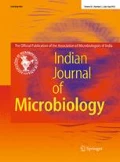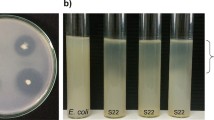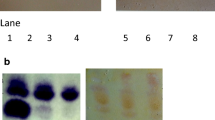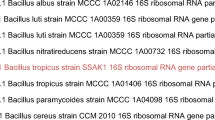Abstract
The ε-caprolactam is the monomer of the synthetic non-degradable nylon-6 and often found as nonreactive component of nylon-6 manufacturing waste effluent. Environmental consequences of its toxicity to natural habitats and humans pose a global public concern. Soil samples were collected from three designated solid waste dumpsites, namely, Abule-Egba, Olusosun and Isheri-Igando in Lagos State, Nigeria. Sixteen bacteria isolated from these samples were found to utilize the ε-caprolactam as a sole source of carbon and nitrogen at concentration of ≤20 g l−1. The isolates were characterized using their 16S rRNA gene sequence and showed similarity with Pseudomonas sp., Proteus sp., Providencia sp., Corynebacterium sp., Lysinibacillus sp., Leucobacter sp., Alcaligenes sp. and Bordetella sp. Their optimal growth conditions were found to be at temperature range of 30 to 35 °C and pH range of 7.0–7.5. High Performance liquid chromatography analysis of the ε-caprolactam from supernatant of growth medium revealed that these isolates have potential to remove 31.6–95.7 % of ε-caprolactam. To the best of our knowledge, this study is first to report the ability of Proteus sp. and Bordetella sp. for ε-caprolactam utilization.



Similar content being viewed by others
References
Altschul SF, Madden TL, Schaffer AA, Zhang J, Zhang Z, Miller W, Lipman DJ (1997) Gapped BLAST and PSI-BLAST: a new generation of protein database search programs. Nucleic Acids Res 25:3389–3402
Ausubel FM, Brent R, Kingston RE, Moore DM, Smith JA, Struhl K (1987) Current protocols in molecular biology. Greene Publishing Associates and Wiley-Interscience, New York
Baxi NN, Shah AK (2000) Biological treatment of the components of solid oligomeric waste from nylon-6 production plant. World J Microbiol Biotechnol 16(8–9):835–840
Baxi NN, Shah AK (2002) ε-caprolactam degradation by Alcaligenes faecalis for remediation of wastewater of nylon-6 production plant. Biotechnol Lett 24(14):1177–1180
Ben-Dov E, Shapiro OH, Siboni N, Kushmaro A (2006) Advantage of using inosine at the 3′ termini of 16S rRNA gene universal primers for the study of microbial diversity. Appl Environ Microbiol 72:6902–6906
Hall TA (1999) BioEdit: a user-friendly biological sequence alignment editor and analysis program for Windows 95/98/NT. Nucleic Acids Symp Ser 41:95–98
Johnson V, Patel SJ, Shah D, Patel KA, Mehta MH (1994) Caprolactam waste liquor degradation by various yeasts. World J Microbiol Biotechnol 10:524–526
Kim OS, Cho YJ, Lee K, Yoon SH, Kim M, Na H, Park SC, Jeon YS, Lee JH, Yi H, Won S, Chun J (2012) Introducing EzTaxon-e: a prokaryotic 16S rRNA Gene sequence database with phylotypes that represent uncultured species. Int J Syst Evol Microbiol 62:716–721
Lee CM, Wang CC (2004) Denitrification with e-caprolactam by acclimated mixed culture and by pure culture of bacteria isolated from polyacrylonitrile fibre manufactured wastewater treatment system. Water Sci Technol 49(5):341–354
Nabegu AB (2010) An analysis of municipal solid waste in Kano metropolis. Niger J Hum Ecol 31(2):111–119
Obire O, Nwaubeta O, Adue SBN (2002) Microbial community of a waste-dump site. J Appl Sci Environ Manag 6(1):78–83
Oviasogie FE, Ajuzie CU, Ighodaro UG (2010) Bacterial analysis of soil from waste dumpsite. Arch Appl Sci Res 2(5):161–167
Pidiyar VJ, Kaznowski A, Badri Narayan N, Patole MS, Shouche YS (2002) Aeromonas culicicola sp. nov. from the midgut of Culex quinquefasciatus. Int J Syst Evol Microbiol 52:1723–1728
Prijambada ID, Negoro S, Yomo T, Urabe I (1995) Emergence of nylon oligomer degradation enzymes in Pseudomonas aeruginosa PAO through experimental evolution. Appl Environ Microbiol 61(5):2020–2022
Tamura K, Peterson D, Peterson N, Stecher G, Nei M, Kumar S (2011) MEGA5: Molecular evolutionary genetics analysis using maximum likelihood, evolutionary distance, and maximum parsimony methods. Mol Biol Evol 28(10):2731–2732
Wang CC, Lee CM (2007) Isolation of the ε-caprolactam denitrifying bacteria from a wastewater treatment system manufactured with acrylonitrile-butadiene-styrene resin. J Hazard Mater 145(1–2):136–141
Xia X, Xie Z (2001) DAMBE: Data analysis in molecular biology and evolution. J Hered 92:371–373
Acknowledgments
Authors are grateful to Dr. Om Prakash Sharma, Microbial Culture Collection (MCC), National Centre for Cell Science (NCCS), Pune for critical reading of the manuscript.
Author information
Authors and Affiliations
Corresponding author
Rights and permissions
About this article
Cite this article
Sanuth, H.A., Yadav, A., Fagade, O.E. et al. ε-Caprolactam Utilization by Proteus sp. and Bordetella sp. Isolated From Solid Waste Dumpsites in Lagos State, Nigeria, First Report. Indian J Microbiol 53, 221–226 (2013). https://doi.org/10.1007/s12088-013-0356-5
Received:
Accepted:
Published:
Issue Date:
DOI: https://doi.org/10.1007/s12088-013-0356-5




